Business Accounting Report: Case Study of Texhong Textile Limited
VerifiedAdded on 2022/06/07
|10
|4069
|22
Report
AI Summary
This report presents a case study analysis of Texhong Textile Limited, focusing on its financial performance and accounting practices. The report begins by identifying the various users of financial statements, including shareholders, management, lenders, and customers, highlighting their respective interests and the information they seek. It then delves into the sources of finance employed by the company, such as share capital, retained earnings, and loan stock (debentures), detailing the characteristics and implications of each. The report also examines the reasons behind the company's cash overdraft, despite its profitability, explaining the challenges of managing short-term financial liabilities and cash flow delays. Overall, the report provides a comprehensive overview of Texhong Textile Limited's financial position, offering insights into its financing strategies and cash management issues.
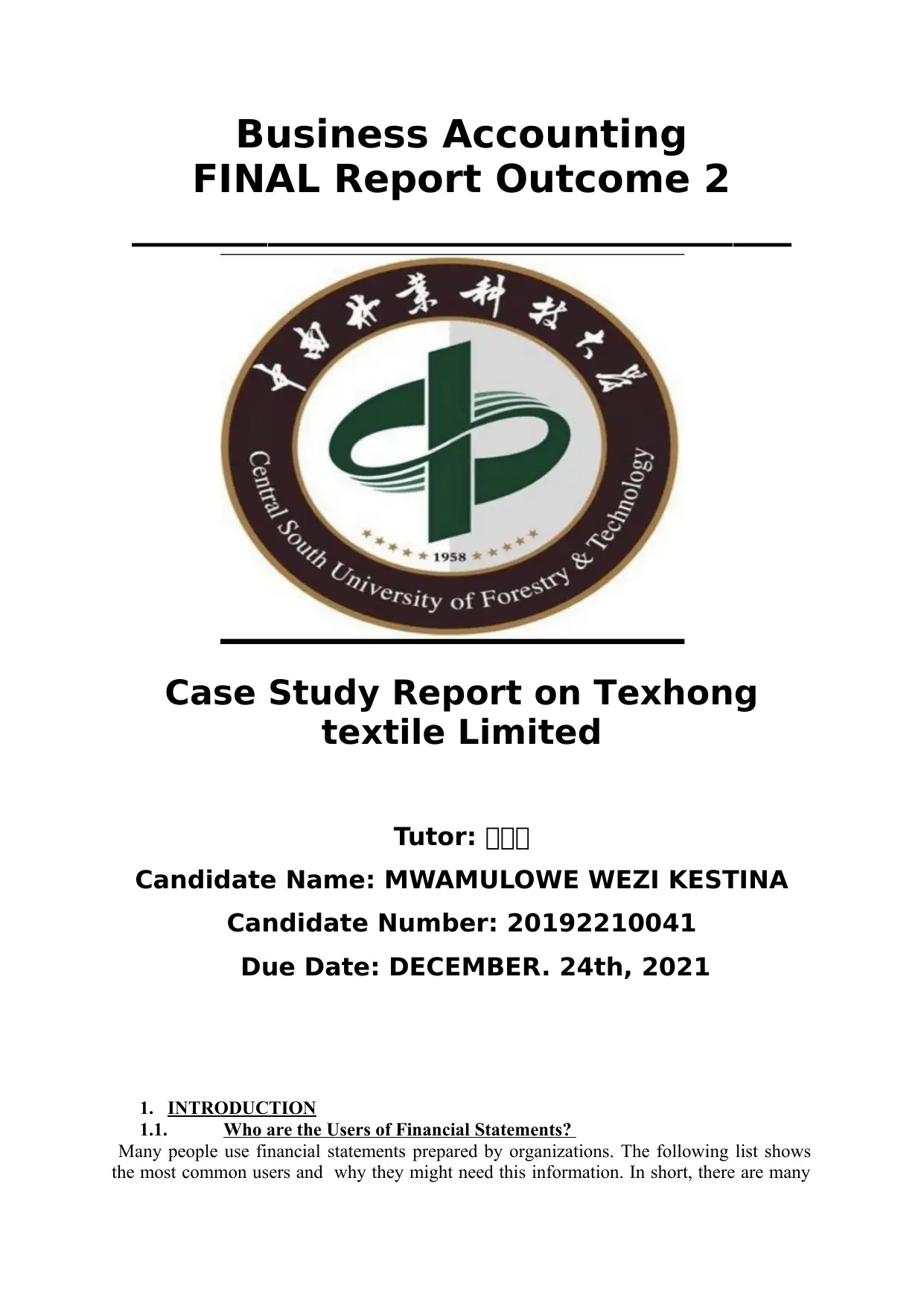
Business Accounting
FINAL Report Outcome 2
__________________________________
Case Study Report on Texhong
textile Limited
Tutor: 王王王
Candidate Name: MWAMULOWE WEZI KESTINA
Candidate Number: 20192210041
Due Date: DECEMBER. 24th, 2021
1. INTRODUCTION
1.1. Who are the Users of Financial Statements?
Many people use financial statements prepared by organizations. The following list shows
the most common users and why they might need this information. In short, there are many
FINAL Report Outcome 2
__________________________________
Case Study Report on Texhong
textile Limited
Tutor: 王王王
Candidate Name: MWAMULOWE WEZI KESTINA
Candidate Number: 20192210041
Due Date: DECEMBER. 24th, 2021
1. INTRODUCTION
1.1. Who are the Users of Financial Statements?
Many people use financial statements prepared by organizations. The following list shows
the most common users and why they might need this information. In short, there are many
Paraphrase This Document
Need a fresh take? Get an instant paraphrase of this document with our AI Paraphraser
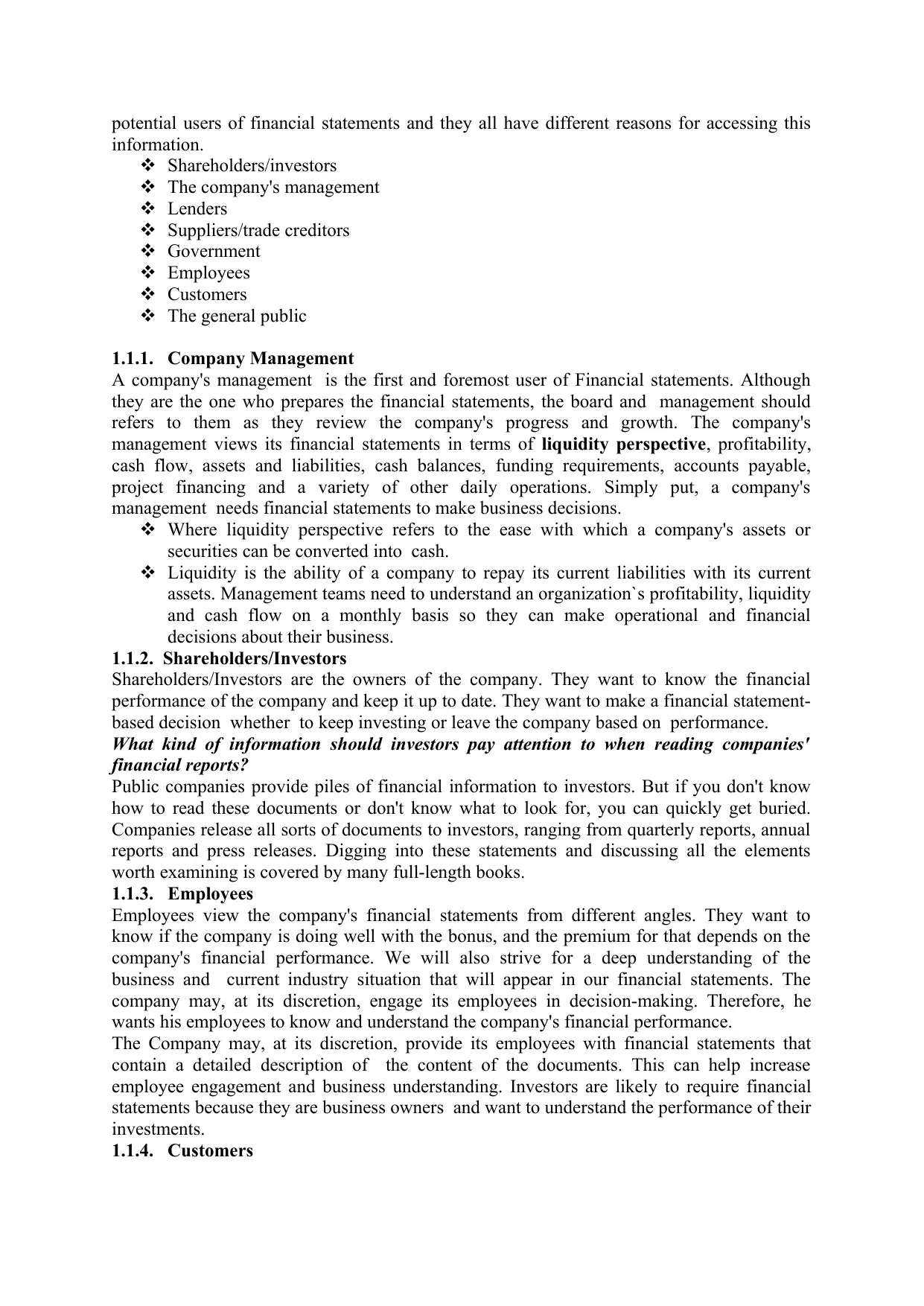
potential users of financial statements and they all have different reasons for accessing this
information.
Shareholders/investors
The company's management
Lenders
Suppliers/trade creditors
Government
Employees
Customers
The general public
1.1.1. Company Management
A company's management is the first and foremost user of Financial statements. Although
they are the one who prepares the financial statements, the board and management should
refers to them as they review the company's progress and growth. The company's
management views its financial statements in terms of liquidity perspective, profitability,
cash flow, assets and liabilities, cash balances, funding requirements, accounts payable,
project financing and a variety of other daily operations. Simply put, a company's
management needs financial statements to make business decisions.
Where liquidity perspective refers to the ease with which a company's assets or
securities can be converted into cash.
Liquidity is the ability of a company to repay its current liabilities with its current
assets. Management teams need to understand an organization`s profitability, liquidity
and cash flow on a monthly basis so they can make operational and financial
decisions about their business.
1.1.2. Shareholders/Investors
Shareholders/Investors are the owners of the company. They want to know the financial
performance of the company and keep it up to date. They want to make a financial statement-
based decision whether to keep investing or leave the company based on performance.
What kind of information should investors pay attention to when reading companies'
financial reports?
Public companies provide piles of financial information to investors. But if you don't know
how to read these documents or don't know what to look for, you can quickly get buried.
Companies release all sorts of documents to investors, ranging from quarterly reports, annual
reports and press releases. Digging into these statements and discussing all the elements
worth examining is covered by many full-length books.
1.1.3. Employees
Employees view the company's financial statements from different angles. They want to
know if the company is doing well with the bonus, and the premium for that depends on the
company's financial performance. We will also strive for a deep understanding of the
business and current industry situation that will appear in our financial statements. The
company may, at its discretion, engage its employees in decision-making. Therefore, he
wants his employees to know and understand the company's financial performance.
The Company may, at its discretion, provide its employees with financial statements that
contain a detailed description of the content of the documents. This can help increase
employee engagement and business understanding. Investors are likely to require financial
statements because they are business owners and want to understand the performance of their
investments.
1.1.4. Customers
information.
Shareholders/investors
The company's management
Lenders
Suppliers/trade creditors
Government
Employees
Customers
The general public
1.1.1. Company Management
A company's management is the first and foremost user of Financial statements. Although
they are the one who prepares the financial statements, the board and management should
refers to them as they review the company's progress and growth. The company's
management views its financial statements in terms of liquidity perspective, profitability,
cash flow, assets and liabilities, cash balances, funding requirements, accounts payable,
project financing and a variety of other daily operations. Simply put, a company's
management needs financial statements to make business decisions.
Where liquidity perspective refers to the ease with which a company's assets or
securities can be converted into cash.
Liquidity is the ability of a company to repay its current liabilities with its current
assets. Management teams need to understand an organization`s profitability, liquidity
and cash flow on a monthly basis so they can make operational and financial
decisions about their business.
1.1.2. Shareholders/Investors
Shareholders/Investors are the owners of the company. They want to know the financial
performance of the company and keep it up to date. They want to make a financial statement-
based decision whether to keep investing or leave the company based on performance.
What kind of information should investors pay attention to when reading companies'
financial reports?
Public companies provide piles of financial information to investors. But if you don't know
how to read these documents or don't know what to look for, you can quickly get buried.
Companies release all sorts of documents to investors, ranging from quarterly reports, annual
reports and press releases. Digging into these statements and discussing all the elements
worth examining is covered by many full-length books.
1.1.3. Employees
Employees view the company's financial statements from different angles. They want to
know if the company is doing well with the bonus, and the premium for that depends on the
company's financial performance. We will also strive for a deep understanding of the
business and current industry situation that will appear in our financial statements. The
company may, at its discretion, engage its employees in decision-making. Therefore, he
wants his employees to know and understand the company's financial performance.
The Company may, at its discretion, provide its employees with financial statements that
contain a detailed description of the content of the documents. This can help increase
employee engagement and business understanding. Investors are likely to require financial
statements because they are business owners and want to understand the performance of their
investments.
1.1.4. Customers
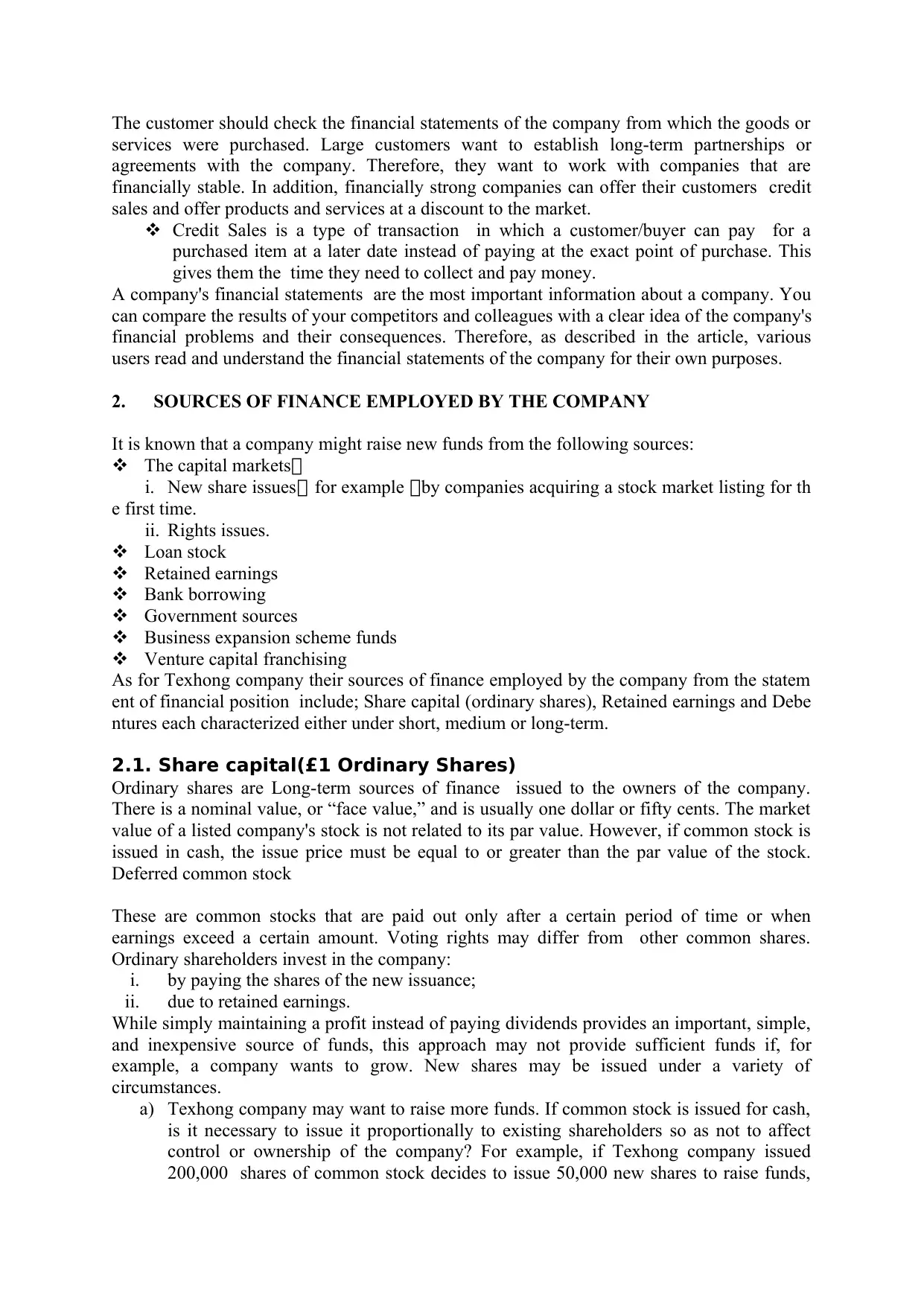
The customer should check the financial statements of the company from which the goods or
services were purchased. Large customers want to establish long-term partnerships or
agreements with the company. Therefore, they want to work with companies that are
financially stable. In addition, financially strong companies can offer their customers credit
sales and offer products and services at a discount to the market.
Credit Sales is a type of transaction in which a customer/buyer can pay for a
purchased item at a later date instead of paying at the exact point of purchase. This
gives them the time they need to collect and pay money.
A company's financial statements are the most important information about a company. You
can compare the results of your competitors and colleagues with a clear idea of the company's
financial problems and their consequences. Therefore, as described in the article, various
users read and understand the financial statements of the company for their own purposes.
2. SOURCES OF FINANCE EMPLOYED BY THE COMPANY
It is known that a company might raise new funds from the following sources:
The capital markets;
i. New share issues; for example ;by companies acquiring a stock market listing for th
e first time.
ii. Rights issues.
Loan stock
Retained earnings
Bank borrowing
Government sources
Business expansion scheme funds
Venture capital franchising
As for Texhong company their sources of finance employed by the company from the statem
ent of financial position include; Share capital (ordinary shares), Retained earnings and Debe
ntures each characterized either under short, medium or long-term.
2.1. Share capital(£1 Ordinary Shares)
Ordinary shares are Long-term sources of finance issued to the owners of the company.
There is a nominal value, or “face value,” and is usually one dollar or fifty cents. The market
value of a listed company's stock is not related to its par value. However, if common stock is
issued in cash, the issue price must be equal to or greater than the par value of the stock.
Deferred common stock
These are common stocks that are paid out only after a certain period of time or when
earnings exceed a certain amount. Voting rights may differ from other common shares.
Ordinary shareholders invest in the company:
i. by paying the shares of the new issuance;
ii. due to retained earnings.
While simply maintaining a profit instead of paying dividends provides an important, simple,
and inexpensive source of funds, this approach may not provide sufficient funds if, for
example, a company wants to grow. New shares may be issued under a variety of
circumstances.
a) Texhong company may want to raise more funds. If common stock is issued for cash,
is it necessary to issue it proportionally to existing shareholders so as not to affect
control or ownership of the company? For example, if Texhong company issued
200,000 shares of common stock decides to issue 50,000 new shares to raise funds,
services were purchased. Large customers want to establish long-term partnerships or
agreements with the company. Therefore, they want to work with companies that are
financially stable. In addition, financially strong companies can offer their customers credit
sales and offer products and services at a discount to the market.
Credit Sales is a type of transaction in which a customer/buyer can pay for a
purchased item at a later date instead of paying at the exact point of purchase. This
gives them the time they need to collect and pay money.
A company's financial statements are the most important information about a company. You
can compare the results of your competitors and colleagues with a clear idea of the company's
financial problems and their consequences. Therefore, as described in the article, various
users read and understand the financial statements of the company for their own purposes.
2. SOURCES OF FINANCE EMPLOYED BY THE COMPANY
It is known that a company might raise new funds from the following sources:
The capital markets;
i. New share issues; for example ;by companies acquiring a stock market listing for th
e first time.
ii. Rights issues.
Loan stock
Retained earnings
Bank borrowing
Government sources
Business expansion scheme funds
Venture capital franchising
As for Texhong company their sources of finance employed by the company from the statem
ent of financial position include; Share capital (ordinary shares), Retained earnings and Debe
ntures each characterized either under short, medium or long-term.
2.1. Share capital(£1 Ordinary Shares)
Ordinary shares are Long-term sources of finance issued to the owners of the company.
There is a nominal value, or “face value,” and is usually one dollar or fifty cents. The market
value of a listed company's stock is not related to its par value. However, if common stock is
issued in cash, the issue price must be equal to or greater than the par value of the stock.
Deferred common stock
These are common stocks that are paid out only after a certain period of time or when
earnings exceed a certain amount. Voting rights may differ from other common shares.
Ordinary shareholders invest in the company:
i. by paying the shares of the new issuance;
ii. due to retained earnings.
While simply maintaining a profit instead of paying dividends provides an important, simple,
and inexpensive source of funds, this approach may not provide sufficient funds if, for
example, a company wants to grow. New shares may be issued under a variety of
circumstances.
a) Texhong company may want to raise more funds. If common stock is issued for cash,
is it necessary to issue it proportionally to existing shareholders so as not to affect
control or ownership of the company? For example, if Texhong company issued
200,000 shares of common stock decides to issue 50,000 new shares to raise funds,
⊘ This is a preview!⊘
Do you want full access?
Subscribe today to unlock all pages.

Trusted by 1+ million students worldwide
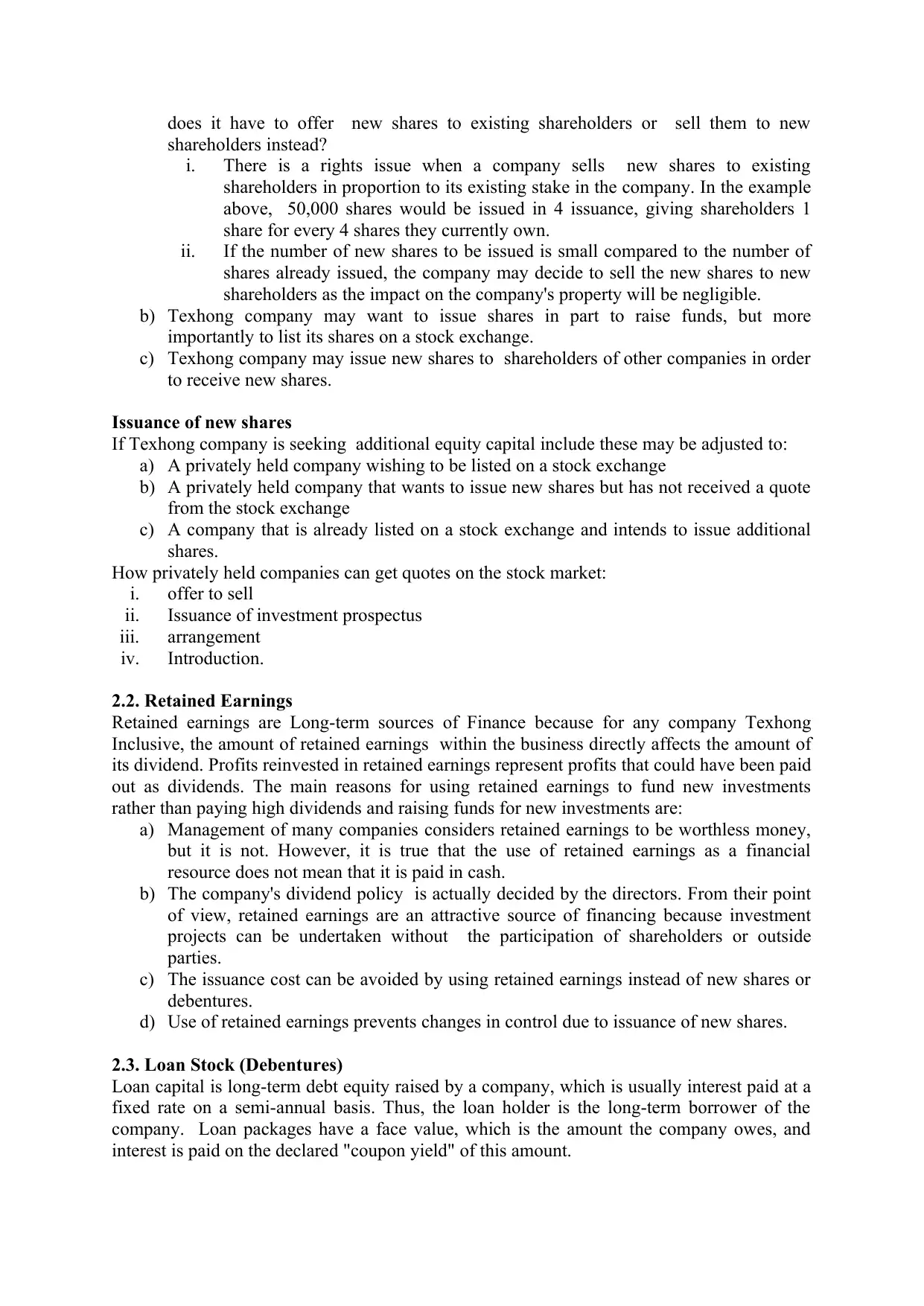
does it have to offer new shares to existing shareholders or sell them to new
shareholders instead?
i. There is a rights issue when a company sells new shares to existing
shareholders in proportion to its existing stake in the company. In the example
above, 50,000 shares would be issued in 4 issuance, giving shareholders 1
share for every 4 shares they currently own.
ii. If the number of new shares to be issued is small compared to the number of
shares already issued, the company may decide to sell the new shares to new
shareholders as the impact on the company's property will be negligible.
b) Texhong company may want to issue shares in part to raise funds, but more
importantly to list its shares on a stock exchange.
c) Texhong company may issue new shares to shareholders of other companies in order
to receive new shares.
Issuance of new shares
If Texhong company is seeking additional equity capital include these may be adjusted to:
a) A privately held company wishing to be listed on a stock exchange
b) A privately held company that wants to issue new shares but has not received a quote
from the stock exchange
c) A company that is already listed on a stock exchange and intends to issue additional
shares.
How privately held companies can get quotes on the stock market:
i. offer to sell
ii. Issuance of investment prospectus
iii. arrangement
iv. Introduction.
2.2. Retained Earnings
Retained earnings are Long-term sources of Finance because for any company Texhong
Inclusive, the amount of retained earnings within the business directly affects the amount of
its dividend. Profits reinvested in retained earnings represent profits that could have been paid
out as dividends. The main reasons for using retained earnings to fund new investments
rather than paying high dividends and raising funds for new investments are:
a) Management of many companies considers retained earnings to be worthless money,
but it is not. However, it is true that the use of retained earnings as a financial
resource does not mean that it is paid in cash.
b) The company's dividend policy is actually decided by the directors. From their point
of view, retained earnings are an attractive source of financing because investment
projects can be undertaken without the participation of shareholders or outside
parties.
c) The issuance cost can be avoided by using retained earnings instead of new shares or
debentures.
d) Use of retained earnings prevents changes in control due to issuance of new shares.
2.3. Loan Stock (Debentures)
Loan capital is long-term debt equity raised by a company, which is usually interest paid at a
fixed rate on a semi-annual basis. Thus, the loan holder is the long-term borrower of the
company. Loan packages have a face value, which is the amount the company owes, and
interest is paid on the declared "coupon yield" of this amount.
shareholders instead?
i. There is a rights issue when a company sells new shares to existing
shareholders in proportion to its existing stake in the company. In the example
above, 50,000 shares would be issued in 4 issuance, giving shareholders 1
share for every 4 shares they currently own.
ii. If the number of new shares to be issued is small compared to the number of
shares already issued, the company may decide to sell the new shares to new
shareholders as the impact on the company's property will be negligible.
b) Texhong company may want to issue shares in part to raise funds, but more
importantly to list its shares on a stock exchange.
c) Texhong company may issue new shares to shareholders of other companies in order
to receive new shares.
Issuance of new shares
If Texhong company is seeking additional equity capital include these may be adjusted to:
a) A privately held company wishing to be listed on a stock exchange
b) A privately held company that wants to issue new shares but has not received a quote
from the stock exchange
c) A company that is already listed on a stock exchange and intends to issue additional
shares.
How privately held companies can get quotes on the stock market:
i. offer to sell
ii. Issuance of investment prospectus
iii. arrangement
iv. Introduction.
2.2. Retained Earnings
Retained earnings are Long-term sources of Finance because for any company Texhong
Inclusive, the amount of retained earnings within the business directly affects the amount of
its dividend. Profits reinvested in retained earnings represent profits that could have been paid
out as dividends. The main reasons for using retained earnings to fund new investments
rather than paying high dividends and raising funds for new investments are:
a) Management of many companies considers retained earnings to be worthless money,
but it is not. However, it is true that the use of retained earnings as a financial
resource does not mean that it is paid in cash.
b) The company's dividend policy is actually decided by the directors. From their point
of view, retained earnings are an attractive source of financing because investment
projects can be undertaken without the participation of shareholders or outside
parties.
c) The issuance cost can be avoided by using retained earnings instead of new shares or
debentures.
d) Use of retained earnings prevents changes in control due to issuance of new shares.
2.3. Loan Stock (Debentures)
Loan capital is long-term debt equity raised by a company, which is usually interest paid at a
fixed rate on a semi-annual basis. Thus, the loan holder is the long-term borrower of the
company. Loan packages have a face value, which is the amount the company owes, and
interest is paid on the declared "coupon yield" of this amount.
Paraphrase This Document
Need a fresh take? Get an instant paraphrase of this document with our AI Paraphraser
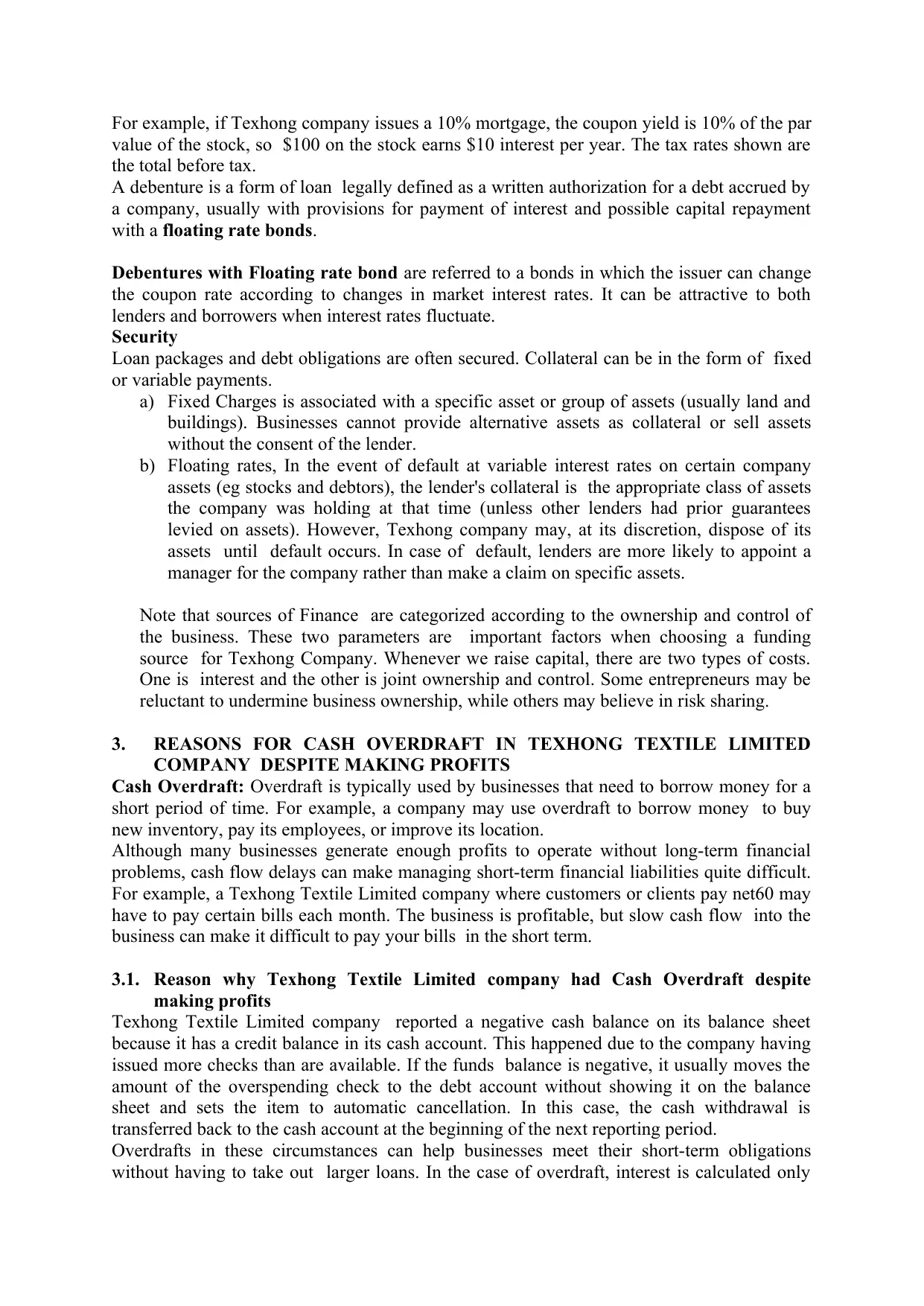
For example, if Texhong company issues a 10% mortgage, the coupon yield is 10% of the par
value of the stock, so $100 on the stock earns $10 interest per year. The tax rates shown are
the total before tax.
A debenture is a form of loan legally defined as a written authorization for a debt accrued by
a company, usually with provisions for payment of interest and possible capital repayment
with a floating rate bonds.
Debentures with Floating rate bond are referred to a bonds in which the issuer can change
the coupon rate according to changes in market interest rates. It can be attractive to both
lenders and borrowers when interest rates fluctuate.
Security
Loan packages and debt obligations are often secured. Collateral can be in the form of fixed
or variable payments.
a) Fixed Charges is associated with a specific asset or group of assets (usually land and
buildings). Businesses cannot provide alternative assets as collateral or sell assets
without the consent of the lender.
b) Floating rates, In the event of default at variable interest rates on certain company
assets (eg stocks and debtors), the lender's collateral is the appropriate class of assets
the company was holding at that time (unless other lenders had prior guarantees
levied on assets). However, Texhong company may, at its discretion, dispose of its
assets until default occurs. In case of default, lenders are more likely to appoint a
manager for the company rather than make a claim on specific assets.
Note that sources of Finance are categorized according to the ownership and control of
the business. These two parameters are important factors when choosing a funding
source for Texhong Company. Whenever we raise capital, there are two types of costs.
One is interest and the other is joint ownership and control. Some entrepreneurs may be
reluctant to undermine business ownership, while others may believe in risk sharing.
3. REASONS FOR CASH OVERDRAFT IN TEXHONG TEXTILE LIMITED
COMPANY DESPITE MAKING PROFITS
Cash Overdraft: Overdraft is typically used by businesses that need to borrow money for a
short period of time. For example, a company may use overdraft to borrow money to buy
new inventory, pay its employees, or improve its location.
Although many businesses generate enough profits to operate without long-term financial
problems, cash flow delays can make managing short-term financial liabilities quite difficult.
For example, a Texhong Textile Limited company where customers or clients pay net60 may
have to pay certain bills each month. The business is profitable, but slow cash flow into the
business can make it difficult to pay your bills in the short term.
3.1. Reason why Texhong Textile Limited company had Cash Overdraft despite
making profits
Texhong Textile Limited company reported a negative cash balance on its balance sheet
because it has a credit balance in its cash account. This happened due to the company having
issued more checks than are available. If the funds balance is negative, it usually moves the
amount of the overspending check to the debt account without showing it on the balance
sheet and sets the item to automatic cancellation. In this case, the cash withdrawal is
transferred back to the cash account at the beginning of the next reporting period.
Overdrafts in these circumstances can help businesses meet their short-term obligations
without having to take out larger loans. In the case of overdraft, interest is calculated only
value of the stock, so $100 on the stock earns $10 interest per year. The tax rates shown are
the total before tax.
A debenture is a form of loan legally defined as a written authorization for a debt accrued by
a company, usually with provisions for payment of interest and possible capital repayment
with a floating rate bonds.
Debentures with Floating rate bond are referred to a bonds in which the issuer can change
the coupon rate according to changes in market interest rates. It can be attractive to both
lenders and borrowers when interest rates fluctuate.
Security
Loan packages and debt obligations are often secured. Collateral can be in the form of fixed
or variable payments.
a) Fixed Charges is associated with a specific asset or group of assets (usually land and
buildings). Businesses cannot provide alternative assets as collateral or sell assets
without the consent of the lender.
b) Floating rates, In the event of default at variable interest rates on certain company
assets (eg stocks and debtors), the lender's collateral is the appropriate class of assets
the company was holding at that time (unless other lenders had prior guarantees
levied on assets). However, Texhong company may, at its discretion, dispose of its
assets until default occurs. In case of default, lenders are more likely to appoint a
manager for the company rather than make a claim on specific assets.
Note that sources of Finance are categorized according to the ownership and control of
the business. These two parameters are important factors when choosing a funding
source for Texhong Company. Whenever we raise capital, there are two types of costs.
One is interest and the other is joint ownership and control. Some entrepreneurs may be
reluctant to undermine business ownership, while others may believe in risk sharing.
3. REASONS FOR CASH OVERDRAFT IN TEXHONG TEXTILE LIMITED
COMPANY DESPITE MAKING PROFITS
Cash Overdraft: Overdraft is typically used by businesses that need to borrow money for a
short period of time. For example, a company may use overdraft to borrow money to buy
new inventory, pay its employees, or improve its location.
Although many businesses generate enough profits to operate without long-term financial
problems, cash flow delays can make managing short-term financial liabilities quite difficult.
For example, a Texhong Textile Limited company where customers or clients pay net60 may
have to pay certain bills each month. The business is profitable, but slow cash flow into the
business can make it difficult to pay your bills in the short term.
3.1. Reason why Texhong Textile Limited company had Cash Overdraft despite
making profits
Texhong Textile Limited company reported a negative cash balance on its balance sheet
because it has a credit balance in its cash account. This happened due to the company having
issued more checks than are available. If the funds balance is negative, it usually moves the
amount of the overspending check to the debt account without showing it on the balance
sheet and sets the item to automatic cancellation. In this case, the cash withdrawal is
transferred back to the cash account at the beginning of the next reporting period.
Overdrafts in these circumstances can help businesses meet their short-term obligations
without having to take out larger loans. In the case of overdraft, interest is calculated only
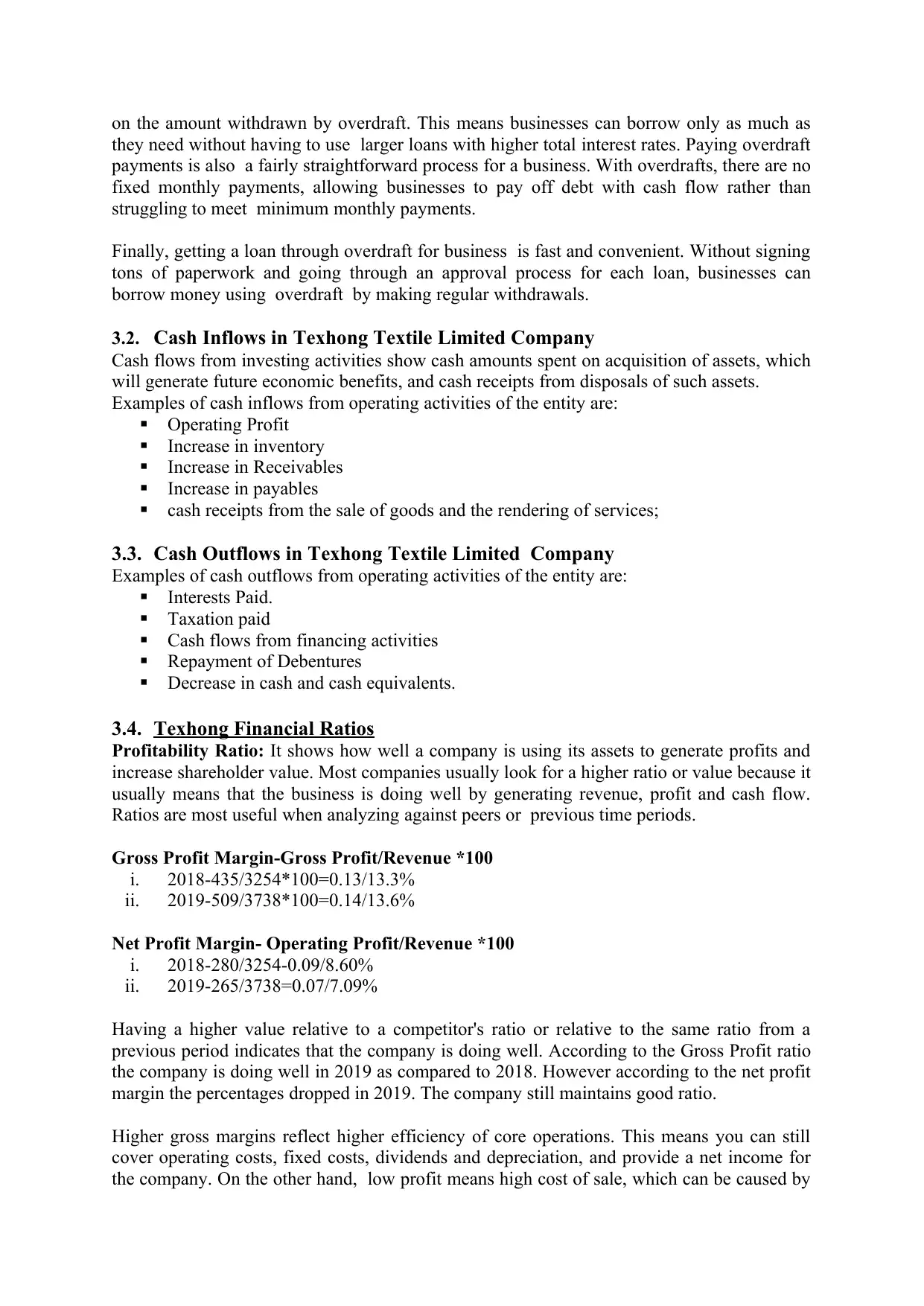
on the amount withdrawn by overdraft. This means businesses can borrow only as much as
they need without having to use larger loans with higher total interest rates. Paying overdraft
payments is also a fairly straightforward process for a business. With overdrafts, there are no
fixed monthly payments, allowing businesses to pay off debt with cash flow rather than
struggling to meet minimum monthly payments.
Finally, getting a loan through overdraft for business is fast and convenient. Without signing
tons of paperwork and going through an approval process for each loan, businesses can
borrow money using overdraft by making regular withdrawals.
3.2. Cash Inflows in Texhong Textile Limited Company
Cash flows from investing activities show cash amounts spent on acquisition of assets, which
will generate future economic benefits, and cash receipts from disposals of such assets.
Examples of cash inflows from operating activities of the entity are:
Operating Profit
Increase in inventory
Increase in Receivables
Increase in payables
cash receipts from the sale of goods and the rendering of services;
3.3. Cash Outflows in Texhong Textile Limited Company
Examples of cash outflows from operating activities of the entity are:
Interests Paid.
Taxation paid
Cash flows from financing activities
Repayment of Debentures
Decrease in cash and cash equivalents.
3.4. Texhong Financial Ratios
Profitability Ratio: It shows how well a company is using its assets to generate profits and
increase shareholder value. Most companies usually look for a higher ratio or value because it
usually means that the business is doing well by generating revenue, profit and cash flow.
Ratios are most useful when analyzing against peers or previous time periods.
Gross Profit Margin-Gross Profit/Revenue *100
i. 2018-435/3254*100=0.13/13.3%
ii. 2019-509/3738*100=0.14/13.6%
Net Profit Margin- Operating Profit/Revenue *100
i. 2018-280/3254-0.09/8.60%
ii. 2019-265/3738=0.07/7.09%
Having a higher value relative to a competitor's ratio or relative to the same ratio from a
previous period indicates that the company is doing well. According to the Gross Profit ratio
the company is doing well in 2019 as compared to 2018. However according to the net profit
margin the percentages dropped in 2019. The company still maintains good ratio.
Higher gross margins reflect higher efficiency of core operations. This means you can still
cover operating costs, fixed costs, dividends and depreciation, and provide a net income for
the company. On the other hand, low profit means high cost of sale, which can be caused by
they need without having to use larger loans with higher total interest rates. Paying overdraft
payments is also a fairly straightforward process for a business. With overdrafts, there are no
fixed monthly payments, allowing businesses to pay off debt with cash flow rather than
struggling to meet minimum monthly payments.
Finally, getting a loan through overdraft for business is fast and convenient. Without signing
tons of paperwork and going through an approval process for each loan, businesses can
borrow money using overdraft by making regular withdrawals.
3.2. Cash Inflows in Texhong Textile Limited Company
Cash flows from investing activities show cash amounts spent on acquisition of assets, which
will generate future economic benefits, and cash receipts from disposals of such assets.
Examples of cash inflows from operating activities of the entity are:
Operating Profit
Increase in inventory
Increase in Receivables
Increase in payables
cash receipts from the sale of goods and the rendering of services;
3.3. Cash Outflows in Texhong Textile Limited Company
Examples of cash outflows from operating activities of the entity are:
Interests Paid.
Taxation paid
Cash flows from financing activities
Repayment of Debentures
Decrease in cash and cash equivalents.
3.4. Texhong Financial Ratios
Profitability Ratio: It shows how well a company is using its assets to generate profits and
increase shareholder value. Most companies usually look for a higher ratio or value because it
usually means that the business is doing well by generating revenue, profit and cash flow.
Ratios are most useful when analyzing against peers or previous time periods.
Gross Profit Margin-Gross Profit/Revenue *100
i. 2018-435/3254*100=0.13/13.3%
ii. 2019-509/3738*100=0.14/13.6%
Net Profit Margin- Operating Profit/Revenue *100
i. 2018-280/3254-0.09/8.60%
ii. 2019-265/3738=0.07/7.09%
Having a higher value relative to a competitor's ratio or relative to the same ratio from a
previous period indicates that the company is doing well. According to the Gross Profit ratio
the company is doing well in 2019 as compared to 2018. However according to the net profit
margin the percentages dropped in 2019. The company still maintains good ratio.
Higher gross margins reflect higher efficiency of core operations. This means you can still
cover operating costs, fixed costs, dividends and depreciation, and provide a net income for
the company. On the other hand, low profit means high cost of sale, which can be caused by
⊘ This is a preview!⊘
Do you want full access?
Subscribe today to unlock all pages.

Trusted by 1+ million students worldwide
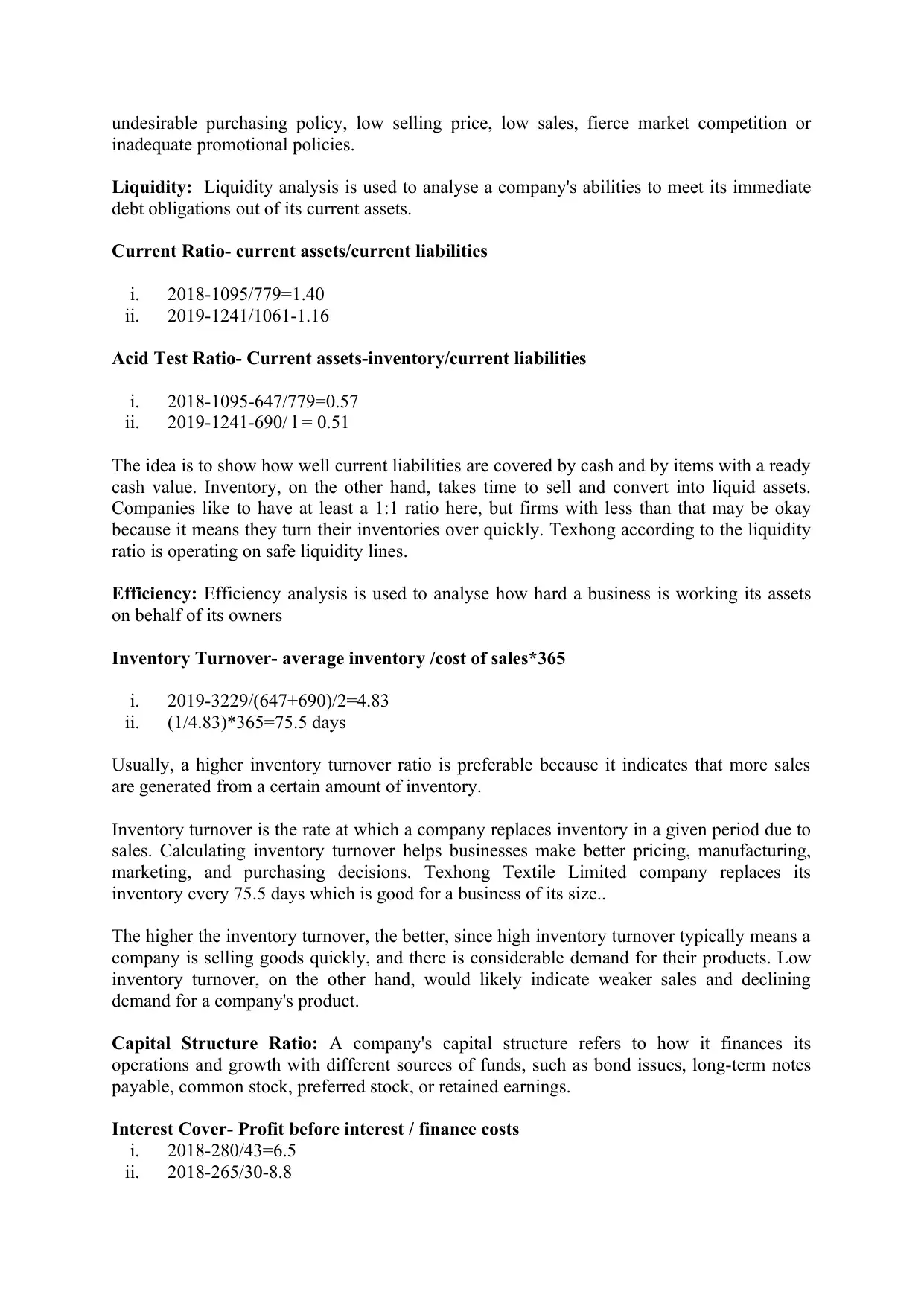
undesirable purchasing policy, low selling price, low sales, fierce market competition or
inadequate promotional policies.
Liquidity: Liquidity analysis is used to analyse a company's abilities to meet its immediate
debt obligations out of its current assets.
Current Ratio- current assets/current liabilities
i. 2018-1095/779=1.40
ii. 2019-1241/1061-1.16
Acid Test Ratio- Current assets-inventory/current liabilities
i. 2018-1095-647/779=0.57
ii. 2019-1241-690/ l = 0.51
The idea is to show how well current liabilities are covered by cash and by items with a ready
cash value. Inventory, on the other hand, takes time to sell and convert into liquid assets.
Companies like to have at least a 1:1 ratio here, but firms with less than that may be okay
because it means they turn their inventories over quickly. Texhong according to the liquidity
ratio is operating on safe liquidity lines.
Efficiency: Efficiency analysis is used to analyse how hard a business is working its assets
on behalf of its owners
Inventory Turnover- average inventory /cost of sales*365
i. 2019-3229/(647+690)/2=4.83
ii. (1/4.83)*365=75.5 days
Usually, a higher inventory turnover ratio is preferable because it indicates that more sales
are generated from a certain amount of inventory.
Inventory turnover is the rate at which a company replaces inventory in a given period due to
sales. Calculating inventory turnover helps businesses make better pricing, manufacturing,
marketing, and purchasing decisions. Texhong Textile Limited company replaces its
inventory every 75.5 days which is good for a business of its size..
The higher the inventory turnover, the better, since high inventory turnover typically means a
company is selling goods quickly, and there is considerable demand for their products. Low
inventory turnover, on the other hand, would likely indicate weaker sales and declining
demand for a company's product.
Capital Structure Ratio: A company's capital structure refers to how it finances its
operations and growth with different sources of funds, such as bond issues, long-term notes
payable, common stock, preferred stock, or retained earnings.
Interest Cover- Profit before interest / finance costs
i. 2018-280/43=6.5
ii. 2018-265/30-8.8
inadequate promotional policies.
Liquidity: Liquidity analysis is used to analyse a company's abilities to meet its immediate
debt obligations out of its current assets.
Current Ratio- current assets/current liabilities
i. 2018-1095/779=1.40
ii. 2019-1241/1061-1.16
Acid Test Ratio- Current assets-inventory/current liabilities
i. 2018-1095-647/779=0.57
ii. 2019-1241-690/ l = 0.51
The idea is to show how well current liabilities are covered by cash and by items with a ready
cash value. Inventory, on the other hand, takes time to sell and convert into liquid assets.
Companies like to have at least a 1:1 ratio here, but firms with less than that may be okay
because it means they turn their inventories over quickly. Texhong according to the liquidity
ratio is operating on safe liquidity lines.
Efficiency: Efficiency analysis is used to analyse how hard a business is working its assets
on behalf of its owners
Inventory Turnover- average inventory /cost of sales*365
i. 2019-3229/(647+690)/2=4.83
ii. (1/4.83)*365=75.5 days
Usually, a higher inventory turnover ratio is preferable because it indicates that more sales
are generated from a certain amount of inventory.
Inventory turnover is the rate at which a company replaces inventory in a given period due to
sales. Calculating inventory turnover helps businesses make better pricing, manufacturing,
marketing, and purchasing decisions. Texhong Textile Limited company replaces its
inventory every 75.5 days which is good for a business of its size..
The higher the inventory turnover, the better, since high inventory turnover typically means a
company is selling goods quickly, and there is considerable demand for their products. Low
inventory turnover, on the other hand, would likely indicate weaker sales and declining
demand for a company's product.
Capital Structure Ratio: A company's capital structure refers to how it finances its
operations and growth with different sources of funds, such as bond issues, long-term notes
payable, common stock, preferred stock, or retained earnings.
Interest Cover- Profit before interest / finance costs
i. 2018-280/43=6.5
ii. 2018-265/30-8.8
Paraphrase This Document
Need a fresh take? Get an instant paraphrase of this document with our AI Paraphraser
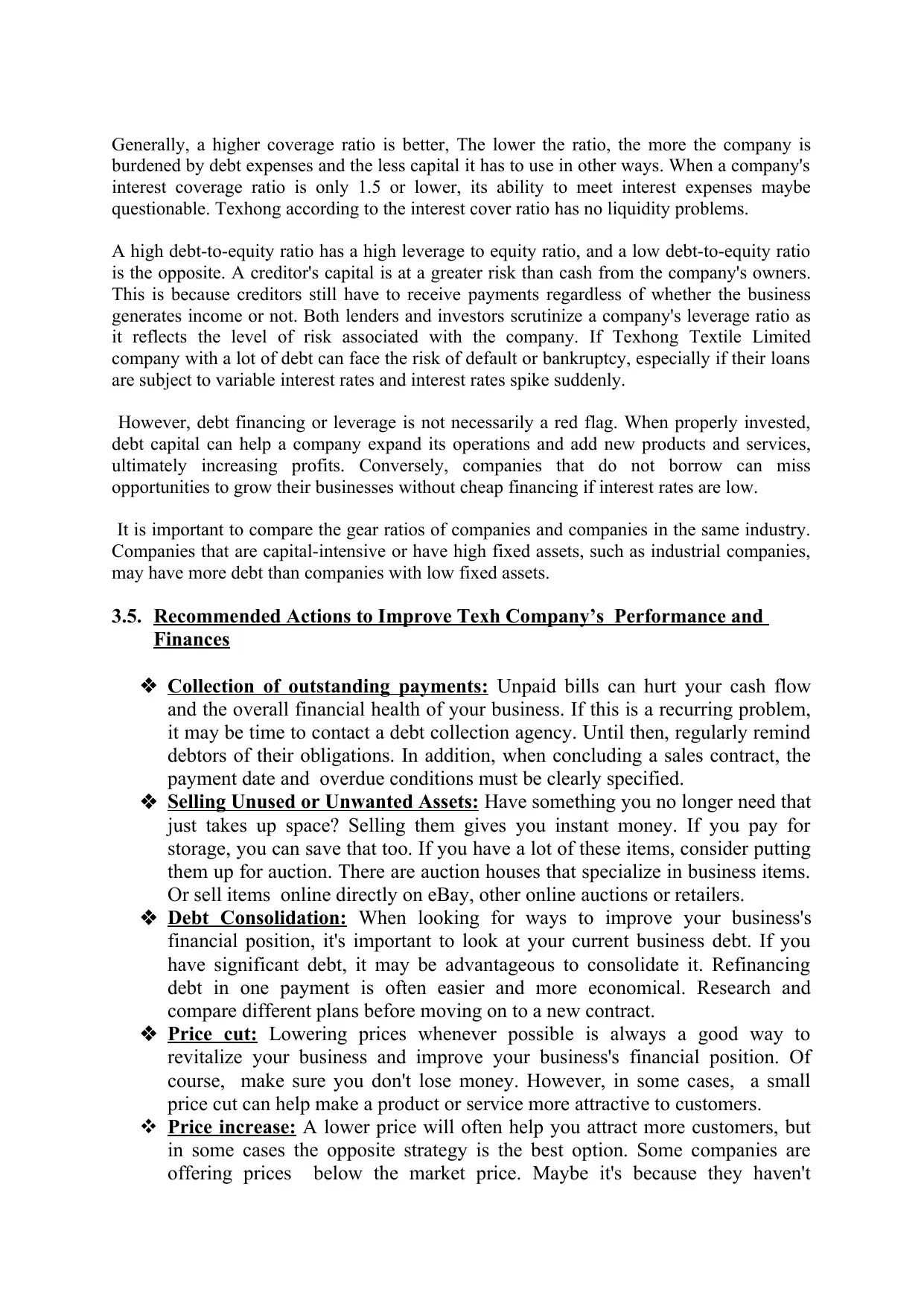
Generally, a higher coverage ratio is better, The lower the ratio, the more the company is
burdened by debt expenses and the less capital it has to use in other ways. When a company's
interest coverage ratio is only 1.5 or lower, its ability to meet interest expenses maybe
questionable. Texhong according to the interest cover ratio has no liquidity problems.
A high debt-to-equity ratio has a high leverage to equity ratio, and a low debt-to-equity ratio
is the opposite. A creditor's capital is at a greater risk than cash from the company's owners.
This is because creditors still have to receive payments regardless of whether the business
generates income or not. Both lenders and investors scrutinize a company's leverage ratio as
it reflects the level of risk associated with the company. If Texhong Textile Limited
company with a lot of debt can face the risk of default or bankruptcy, especially if their loans
are subject to variable interest rates and interest rates spike suddenly.
However, debt financing or leverage is not necessarily a red flag. When properly invested,
debt capital can help a company expand its operations and add new products and services,
ultimately increasing profits. Conversely, companies that do not borrow can miss
opportunities to grow their businesses without cheap financing if interest rates are low.
It is important to compare the gear ratios of companies and companies in the same industry.
Companies that are capital-intensive or have high fixed assets, such as industrial companies,
may have more debt than companies with low fixed assets.
3.5. Recommended Actions to Improve Texh Company’s Performance and
Finances
Collection of outstanding payments: Unpaid bills can hurt your cash flow
and the overall financial health of your business. If this is a recurring problem,
it may be time to contact a debt collection agency. Until then, regularly remind
debtors of their obligations. In addition, when concluding a sales contract, the
payment date and overdue conditions must be clearly specified.
Selling Unused or Unwanted Assets: Have something you no longer need that
just takes up space? Selling them gives you instant money. If you pay for
storage, you can save that too. If you have a lot of these items, consider putting
them up for auction. There are auction houses that specialize in business items.
Or sell items online directly on eBay, other online auctions or retailers.
Debt Consolidation: When looking for ways to improve your business's
financial position, it's important to look at your current business debt. If you
have significant debt, it may be advantageous to consolidate it. Refinancing
debt in one payment is often easier and more economical. Research and
compare different plans before moving on to a new contract.
Price cut: Lowering prices whenever possible is always a good way to
revitalize your business and improve your business's financial position. Of
course, make sure you don't lose money. However, in some cases, a small
price cut can help make a product or service more attractive to customers.
Price increase: A lower price will often help you attract more customers, but
in some cases the opposite strategy is the best option. Some companies are
offering prices below the market price. Maybe it's because they haven't
burdened by debt expenses and the less capital it has to use in other ways. When a company's
interest coverage ratio is only 1.5 or lower, its ability to meet interest expenses maybe
questionable. Texhong according to the interest cover ratio has no liquidity problems.
A high debt-to-equity ratio has a high leverage to equity ratio, and a low debt-to-equity ratio
is the opposite. A creditor's capital is at a greater risk than cash from the company's owners.
This is because creditors still have to receive payments regardless of whether the business
generates income or not. Both lenders and investors scrutinize a company's leverage ratio as
it reflects the level of risk associated with the company. If Texhong Textile Limited
company with a lot of debt can face the risk of default or bankruptcy, especially if their loans
are subject to variable interest rates and interest rates spike suddenly.
However, debt financing or leverage is not necessarily a red flag. When properly invested,
debt capital can help a company expand its operations and add new products and services,
ultimately increasing profits. Conversely, companies that do not borrow can miss
opportunities to grow their businesses without cheap financing if interest rates are low.
It is important to compare the gear ratios of companies and companies in the same industry.
Companies that are capital-intensive or have high fixed assets, such as industrial companies,
may have more debt than companies with low fixed assets.
3.5. Recommended Actions to Improve Texh Company’s Performance and
Finances
Collection of outstanding payments: Unpaid bills can hurt your cash flow
and the overall financial health of your business. If this is a recurring problem,
it may be time to contact a debt collection agency. Until then, regularly remind
debtors of their obligations. In addition, when concluding a sales contract, the
payment date and overdue conditions must be clearly specified.
Selling Unused or Unwanted Assets: Have something you no longer need that
just takes up space? Selling them gives you instant money. If you pay for
storage, you can save that too. If you have a lot of these items, consider putting
them up for auction. There are auction houses that specialize in business items.
Or sell items online directly on eBay, other online auctions or retailers.
Debt Consolidation: When looking for ways to improve your business's
financial position, it's important to look at your current business debt. If you
have significant debt, it may be advantageous to consolidate it. Refinancing
debt in one payment is often easier and more economical. Research and
compare different plans before moving on to a new contract.
Price cut: Lowering prices whenever possible is always a good way to
revitalize your business and improve your business's financial position. Of
course, make sure you don't lose money. However, in some cases, a small
price cut can help make a product or service more attractive to customers.
Price increase: A lower price will often help you attract more customers, but
in some cases the opposite strategy is the best option. Some companies are
offering prices below the market price. Maybe it's because they haven't
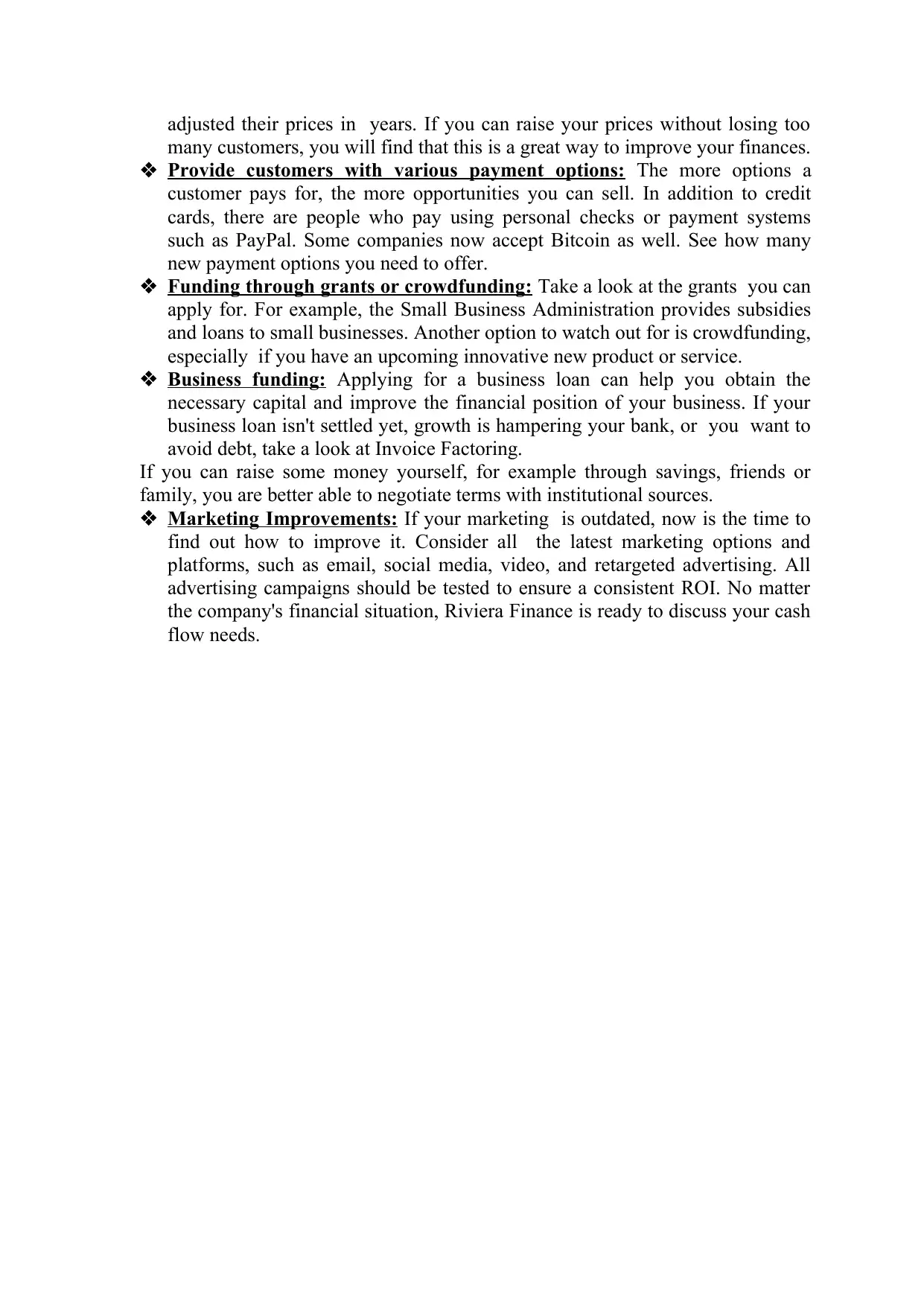
adjusted their prices in years. If you can raise your prices without losing too
many customers, you will find that this is a great way to improve your finances.
Provide customers with various payment options: The more options a
customer pays for, the more opportunities you can sell. In addition to credit
cards, there are people who pay using personal checks or payment systems
such as PayPal. Some companies now accept Bitcoin as well. See how many
new payment options you need to offer.
Funding through grants or crowdfunding: Take a look at the grants you can
apply for. For example, the Small Business Administration provides subsidies
and loans to small businesses. Another option to watch out for is crowdfunding,
especially if you have an upcoming innovative new product or service.
Business funding: Applying for a business loan can help you obtain the
necessary capital and improve the financial position of your business. If your
business loan isn't settled yet, growth is hampering your bank, or you want to
avoid debt, take a look at Invoice Factoring.
If you can raise some money yourself, for example through savings, friends or
family, you are better able to negotiate terms with institutional sources.
Marketing Improvements: If your marketing is outdated, now is the time to
find out how to improve it. Consider all the latest marketing options and
platforms, such as email, social media, video, and retargeted advertising. All
advertising campaigns should be tested to ensure a consistent ROI. No matter
the company's financial situation, Riviera Finance is ready to discuss your cash
flow needs.
many customers, you will find that this is a great way to improve your finances.
Provide customers with various payment options: The more options a
customer pays for, the more opportunities you can sell. In addition to credit
cards, there are people who pay using personal checks or payment systems
such as PayPal. Some companies now accept Bitcoin as well. See how many
new payment options you need to offer.
Funding through grants or crowdfunding: Take a look at the grants you can
apply for. For example, the Small Business Administration provides subsidies
and loans to small businesses. Another option to watch out for is crowdfunding,
especially if you have an upcoming innovative new product or service.
Business funding: Applying for a business loan can help you obtain the
necessary capital and improve the financial position of your business. If your
business loan isn't settled yet, growth is hampering your bank, or you want to
avoid debt, take a look at Invoice Factoring.
If you can raise some money yourself, for example through savings, friends or
family, you are better able to negotiate terms with institutional sources.
Marketing Improvements: If your marketing is outdated, now is the time to
find out how to improve it. Consider all the latest marketing options and
platforms, such as email, social media, video, and retargeted advertising. All
advertising campaigns should be tested to ensure a consistent ROI. No matter
the company's financial situation, Riviera Finance is ready to discuss your cash
flow needs.
⊘ This is a preview!⊘
Do you want full access?
Subscribe today to unlock all pages.

Trusted by 1+ million students worldwide
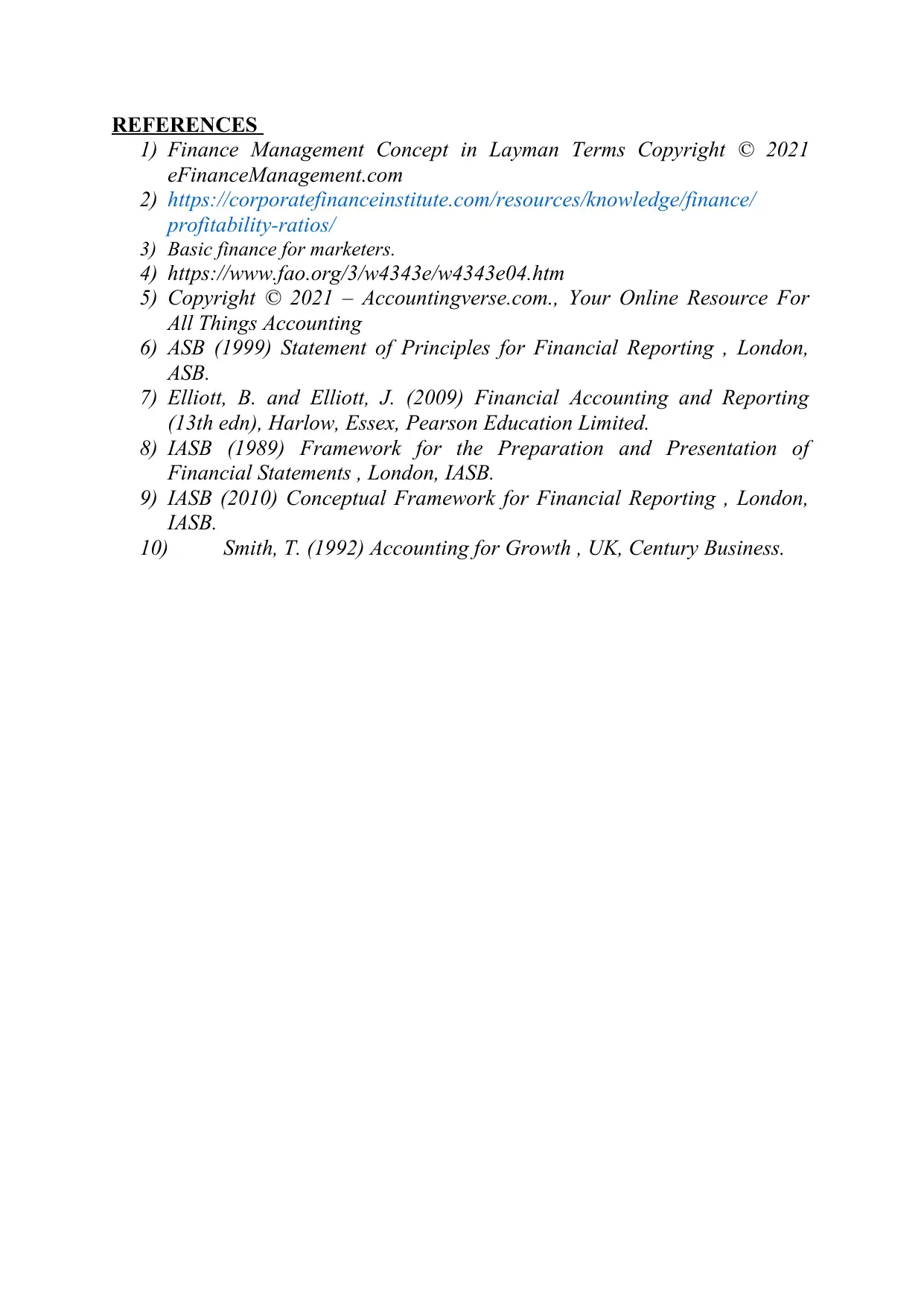
REFERENCES
1) Finance Management Concept in Layman Terms Copyright © 2021
eFinanceManagement.com
2) https://corporatefinanceinstitute.com/resources/knowledge/finance/
profitability-ratios/
3) Basic finance for marketers.
4) https://www.fao.org/3/w4343e/w4343e04.htm
5) Copyright © 2021 – Accountingverse.com., Your Online Resource For
All Things Accounting
6) ASB (1999) Statement of Principles for Financial Reporting , London,
ASB.
7) Elliott, B. and Elliott, J. (2009) Financial Accounting and Reporting
(13th edn), Harlow, Essex, Pearson Education Limited.
8) IASB (1989) Framework for the Preparation and Presentation of
Financial Statements , London, IASB.
9) IASB (2010) Conceptual Framework for Financial Reporting , London,
IASB.
10) Smith, T. (1992) Accounting for Growth , UK, Century Business.
1) Finance Management Concept in Layman Terms Copyright © 2021
eFinanceManagement.com
2) https://corporatefinanceinstitute.com/resources/knowledge/finance/
profitability-ratios/
3) Basic finance for marketers.
4) https://www.fao.org/3/w4343e/w4343e04.htm
5) Copyright © 2021 – Accountingverse.com., Your Online Resource For
All Things Accounting
6) ASB (1999) Statement of Principles for Financial Reporting , London,
ASB.
7) Elliott, B. and Elliott, J. (2009) Financial Accounting and Reporting
(13th edn), Harlow, Essex, Pearson Education Limited.
8) IASB (1989) Framework for the Preparation and Presentation of
Financial Statements , London, IASB.
9) IASB (2010) Conceptual Framework for Financial Reporting , London,
IASB.
10) Smith, T. (1992) Accounting for Growth , UK, Century Business.
1 out of 10
Related Documents
Your All-in-One AI-Powered Toolkit for Academic Success.
+13062052269
info@desklib.com
Available 24*7 on WhatsApp / Email
![[object Object]](/_next/static/media/star-bottom.7253800d.svg)
Unlock your academic potential
Copyright © 2020–2025 A2Z Services. All Rights Reserved. Developed and managed by ZUCOL.





